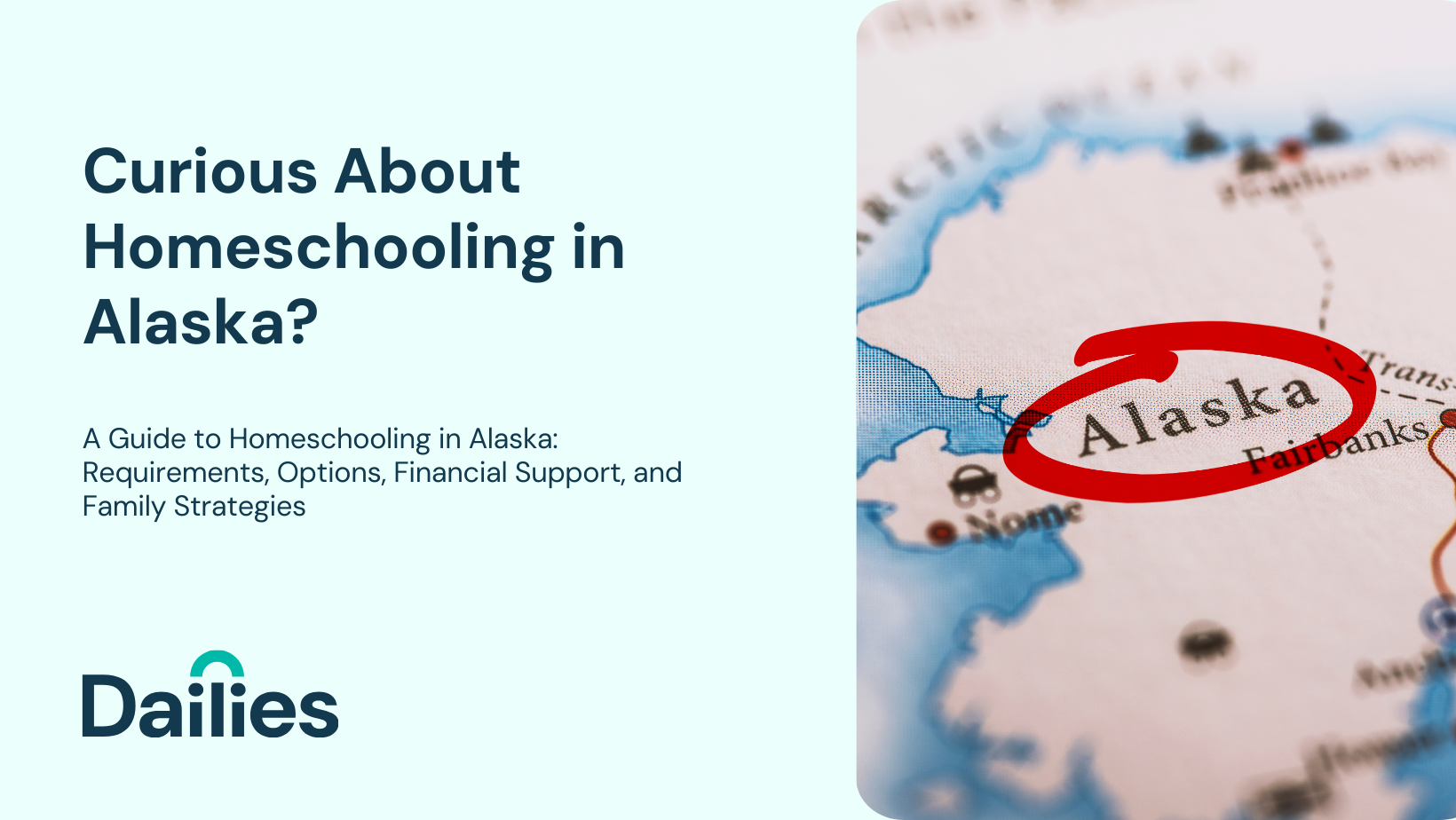Written by
Jillian Burger Read all posts by this author
Guide to Homeschooling in Alaska: Requirements, Options, Financial Support, and Family Strategies
Homeschooling in Alaska offers families unparalleled flexibility, thanks to the state’s supportive homeschooling laws and abundant resources. Whether you’re just starting your homeschooling journey or refining your approach, understanding Alaska’s unique homeschooling landscape is essential.
In this guide, we’ll explore Alaska’s homeschooling requirements, the educational options available, financial support opportunities, and strategies for making homeschooling work for families with children of various ages. Dailies is here to make sure your homeschooling journey is a success.
Homeschooling Requirements in Alaska
Understanding Alaska Homeschool Laws
Alaska is one of the most homeschool-friendly states in the U.S., offering several legal pathways for homeschooling families. You can choose the approach that best fits your family’s needs:
- Homeschooling under the Homeschool Statute: Parents act as the primary educators and have complete control over curriculum and teaching methods, with no requirement to notify the state.
- Private School Option: Parents establish a private school in their home and meet minimal reporting requirements.
- Enrollment in a Correspondence Program: Families enroll in a state-recognized correspondence program, which often provides additional resources and accountability.
Filing Requirements and Record-Keeping
If you homeschool independently, Alaska does not require you to file any notification with the state. However, families enrolled in correspondence programs must follow the reporting and attendance guidelines set by the program.
Even when not legally required, keeping records such as attendance, coursework, and completed assignments is a good practice. These records can be helpful if you decide to transition back to public school or for future college applications.
Exploring Homeschooling Options in Alaska
Independent Homeschooling
This option gives families full control over curriculum design and teaching methods. Parents can choose from a variety of curriculums, ranging from traditional textbooks to project-based learning and experiential education. Dailies offers great supplemental classes for the independent homeschooling family such as enrichment classes, tutoring and small group pods, to give students that extra boost and allow for social learning experiences.
State-Supported Correspondence Schools
Alaska is unique in offering state-supported correspondence programs for homeschoolers, often referred to as “homeschool allotments.” Programs such as IDEA Homeschool, Raven Homeschool, and CyberLynx provide families with financial allotments to purchase educational materials and access extracurricular activities.
Hybrid and Part-Time Options
Many school districts in Alaska allow part-time enrollment for homeschooled students. This option lets children attend public school classes or participate in sports and extracurricular activities while continuing their primary education at home.
Homeschool Co-ops and Learning Pods
Homeschooling co-ops in Alaska provide opportunities for group learning, socialization, and shared teaching responsibilities. Co-ops often organize field trips, STEM activities, and enrichment classes that align with the state’s rich outdoor and cultural resources.
Financial Support for Homeschooling in Alaska
Homeschool Allotments
Alaska’s state-supported correspondence programs provide financial allotments to families for homeschooling expenses. These funds can be used for purchasing curriculum, technology, extracurricular activities, and even music or art lessons. The amount varies by program but can range from $1,500 to $4,000 per student annually.
Free and Low-Cost Resources
Alaska offers numerous free or low-cost resources for homeschooling families, including:
- Public Libraries: Access to books, educational kits, and online databases.
- Museums and Cultural Centers: Many offer free or discounted admission for homeschoolers.
- State and National Parks: Alaska’s stunning parks are perfect for hands-on learning about science, geography, and history.
Tax Considerations
Alaska does not impose state income tax, so there are no homeschooling-related tax credits or deductions. However, families can maximize their homeschool allotments and take advantage of free community resources to minimize expenses.
Creating a Homeschool Plan for Families with Multiple Children
Establishing a Flexible Routine
Alaska’s unique environment encourages a flexible approach to homeschooling. Many families adopt a seasonal schedule, integrating outdoor activities like fishing, hiking, and wildlife observation into their learning plans.
Multi-Age Learning Strategies
Subjects like science, history, and geography can be taught as a family using multi-age curriculums. Programs like Mystery Science or Unit Studies by Amanda Bennett allow children of different ages to explore the same topics at varying depth levels.
Encouraging Independent Learning
Older students can engage in self-paced online courses while younger children work on hands-on activities or creative projects. Resources like Khan Academy and Time4Learning are excellent for fostering independent study.
Outdoor and Experiential Learning
Alaska’s breathtaking landscapes provide countless opportunities for experiential learning. Families can incorporate activities like observing wildlife, exploring glaciers, and studying Native Alaskan cultures into their homeschool plans.
Building Community and Navigating Challenges
Finding Support Networks
Alaska’s homeschooling community is vibrant and welcoming. Groups like the Alaska Private and Home Educators Association (APHEA) offer events, workshops, and connections to other homeschooling families. Joining local Facebook groups or attending community events can also help you find support.
Managing Multiple Roles
Balancing parenting and teaching can be challenging. Many families in Alaska rely on co-ops, correspondence programs, or hired tutors to share teaching responsibilities. Don’t hesitate to delegate tasks or seek support when needed.
Supporting Special Needs Learners
Homeschooling allows parents to create a tailored educational plan for children with special needs. Many correspondence programs in Alaska offer additional support for special education. Parents can also access local public school resources for therapies or testing.
Tracking Progress and Goals
Even if not required by law, setting goals and tracking progress helps ensure your children are meeting their educational milestones. Create portfolios that showcase work samples, test scores, and achievements for each child.
Conclusion
Homeschooling in Alaska provides families with unparalleled freedom and access to resources that enhance learning. Whether you choose to homeschool independently, through a correspondence program, or as part of a hybrid model, the possibilities are vast.
Alaska’s generous homeschool allotments, coupled with its rich natural and cultural resources, make it one of the most homeschool-friendly states in the country. By understanding the legal requirements, exploring your options, and building a plan tailored to your family, you can create a fulfilling homeschooling experience that prepares your children for lifelong success.
Ready to start your homeschooling journey in Alaska? Dive into the state’s resources, connect with local support groups, and embrace the adventure of educating your children in the Last Frontier!

